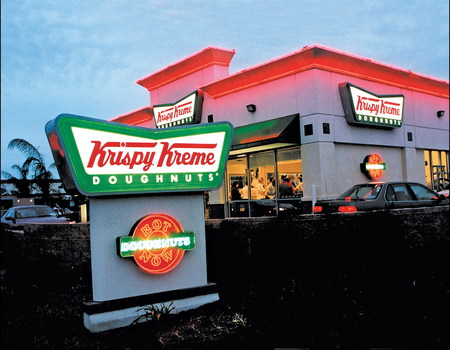When fabricating illuminated signs, your main goal is to ensure proper lighting, because sign buyers expect illuminated signs to appear equally dynamic in daylight or at night. Thus, choosing and installing the proper light fixtures is imperative. However, face colors, cabinet depth or a signface changeover may require design or specification modifications.
Face replacements
Several years ago, we experienced trouble replacing the faces on an existing, 6 x 10-ft., double-face, 12-in.-wide, aluminum-extruded sign cabinet. The original designer had complied with the standard, cabinet-fabrication rules, that is, placing the fluorescent lamps 12 in. apart, center to center, along the cabinet’s center axis.
The sign’s previous faces comprised black text over a yellow field – not, to my mind, aesthetically pleasing, but certainly bright and readable. The customer’s new face choice was white copy over a blue field. When we tested the refurbished sign, we saw multiple hot spots – you could count every lamp!
Why did we now have hot spots, but none with the previous (yellow) faces? Because warm-colored sign faces diffuse light better than ones with cool colors. The sign’s original yellow field diffused the light, but the new, blue background, a cool color, allowed inborn hot spots to appear.
Some signmakers think you can’t fix such common occurrences, but several solutions exist.
Advertisement
First things first
To solve the hotspot (or shadow) dilemma, you must first determine the problem. If you can easily count the lamps through the sign face, you’re seeing hot spots. If you can’t count lamps, the varying color problem is shadows. Hotspots demand less light, or more diffused light. To cure shadows, simply add light.
On the blue-faced sign, we could count the lamps, so it had hot spots, i.e., too much light. To fix it, we recommended vacuumformed sign faces to our customer, to gain width and lessen the lamps’ effect.
A plastic, vacuumformed sign face is heated and formed into a three-dimensional shape – a flanged flat or a molded, embossed sign face, for example. You can install vacuumformed faces in internally illuminated sign cabinets or channel letters.
Cures for hot spots
• Change to daylight lamps. If the sign had cool-white fluorescent lamps, change to daylight-type lamps. Daylight lamps have a lower lumen yield, and the output color is more conducive to cool-colored faces.
Advertisement
• Widen the overall sign. Many extrusions aren’t always as wide as the manufacturer’s specification – you often find a true, 11-in. width on a specified 12-in.-wide cabinet. The extra inch may help, and you can get it, or even more, by installing vacuumformed sign faces.
I learned this by studying production sign companies that cut their extrusion/cabinet costs by installing 3-in.-wide, vacuumformed faces on narrow cabinets, to deepen the display width and help eliminate hot spots. Anytime you widen a sign cabinet, you lessen the chance of hot spots.
• Increase the face’s translucency. Alter the face’s transparency by painting the second surface, thereby reducing the amount of emitted light.
Adding light to reduce shadows means just that, and you can accomplish this via several methods: painting the sign’s interior white or breaking the 12-in. rule and spacing the lamps (or neon tubes) more closely together.
One neat trick
You never know what you’ll find in a customer’s sign cabinet. Once, I found strips of white masking tape applied along the fluorescent lamp’s leading edges. In an 8-in.-wide cabinet with flat faces, someone stuck a few layers of tape on the fluorescent lamps, to lessen their lumen output and reduce hot spots. I’m not sure how the display was originally fabricated, or if someone substituted flat faces for formed ones. My new, replacement lamps caused the hot spots, and, in the end, I duplicated the previous serviceperson’s cure by buying white masking tape at a local hardware and sticking it on the lamps. It’s a neat trick if you’re in a bind, but I don’t suggest it for fabricating.
Advertisement
Channel letters
You’ll find hot spots and shadows in channel letters, too. Our company once fabricated a set of turquoise, green-faced (Plexiglas® acrylic) channel letters for a furniture store, and, when we test lit them, we could see every neon tube. We’d painted the channel-letter interiors white to help diffuse the light, but too late realized the green plex was semi-transparent. We couldn’t widen the returns, so we had to reduce the amount of light. The cure? We removed the faces and painted their second-surface white.
Shadows in channel letters are common, especially in argon or white, neon-based letters White or argon, illuminated channel letters typically require more glass tubes than a red neon unit. I’ve seen red neon spaced as much as 6 in. apart, without shadows, but not white neon. If you don’t want shadows, keep your pattern tight; bending the tubes into serif corners also helps.
In summary, know that hotspots and shadows will always exist, even as our technology and media change. Just remember to ask yourself if the light variance is a shadow or hot spot. When you recognize the problem, the solution is not too far away.


 Photo Gallery1 week ago
Photo Gallery1 week ago
 Ask Signs of the Times2 weeks ago
Ask Signs of the Times2 weeks ago
 Paula Fargo1 week ago
Paula Fargo1 week ago
 Real Deal5 days ago
Real Deal5 days ago
 Photo Gallery1 week ago
Photo Gallery1 week ago
 Women in Signs2 weeks ago
Women in Signs2 weeks ago
 Women in Signs2 weeks ago
Women in Signs2 weeks ago
 Projects5 days ago
Projects5 days ago
















